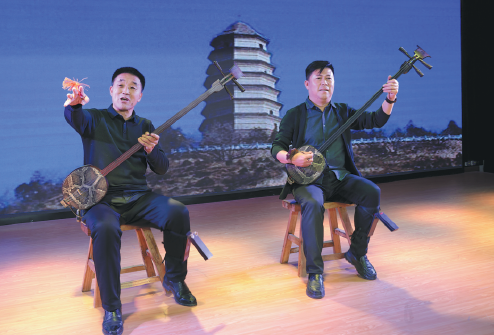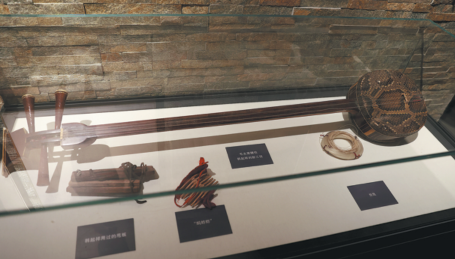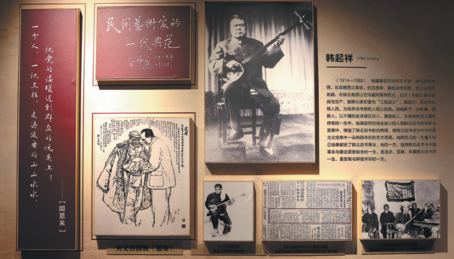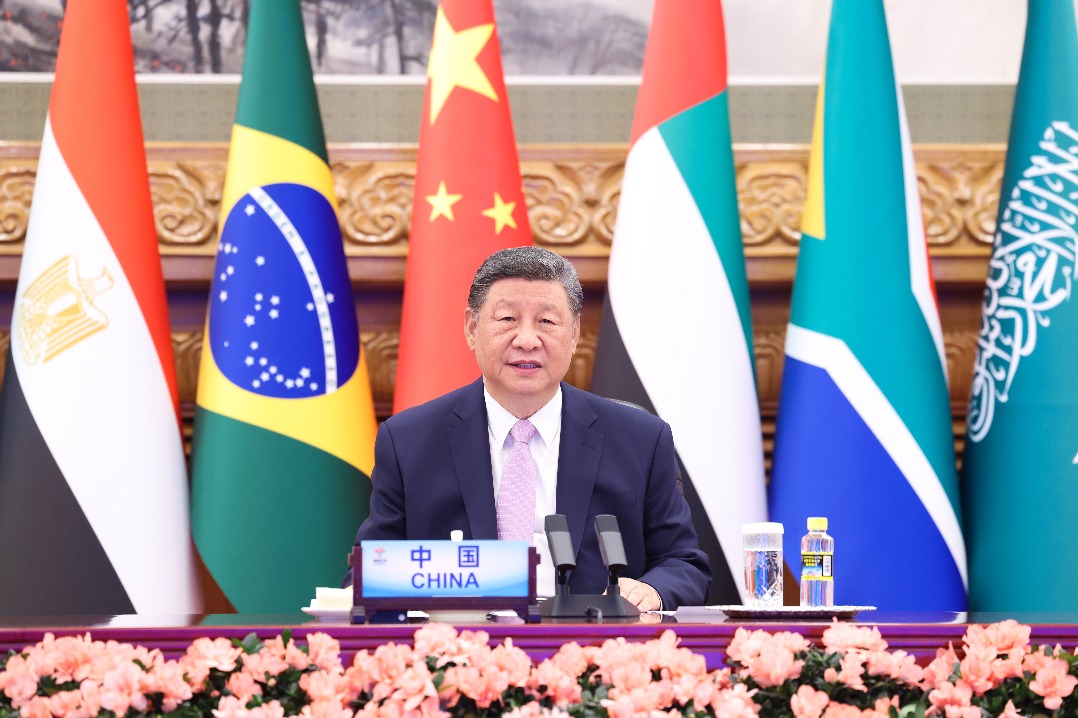The art of painting pictures with words
Recent boost by popular video game takes Shaanbei storytelling tradition to young audiences, Chen Nan reports.

"I will ask everyone to sit still, and let me tell you a story about the fierce wind in my hometown," says He Lianshan, sitting in the center of the stage, holding his sanxian, a long-necked, plucked string instrument.
With a deep breath, He clears his throat and begins.
"In the spring, the wind blows warm and gentle. In the summer, the wind blows hot and dry. In the autumn, the wind blows cool and crisp. In the winter, the wind blows cold enough to freeze you solid," he sings, his face constantly shifting between playful and dramatic, capturing the character and intensity of the wind. His voice, rich, hoarse, and powerful, rises and falls in a rhythmic cadence, each word carefully shaped to evoke the wind in the city of Zichang, Shaanxi province.
Besides plucking the strings of his instrument, his hands move in the air as if he is painting pictures of the scenes described in his lyrics. The audience is captivated, hanging on his every word and note, laughing at his humorous portrayal.
Every week, the seasoned 58-year-old artist performs Shaanbei (northern Shaanxi) Shuoshu, a traditional form of oral performance art from Shaanxi province. The term shuoshu means storytelling, and this art form has deep roots in folk culture, particularly in rural northwestern China.
This ancient tradition requires neither stage nor props — just the raw energy of the storyteller's voice and the imagination of the audience.
He is a famous storyteller in Shaanxi who now lives in Yan'an, an important former revolutionary base in the province. One of his disciples, Xiong Zhuying, went viral on social media for performing Shaanbei storytelling during the opening of the second chapter of the Chinese video game Black Myth: Wukong, which became a global hit.
Since then, He's schedule has become busier. He performs all over the country to introduce the art form to a wider audience.
"I have more than 100 disciples, and Xiong has had the opportunity to take the art form to another level. I read many comments left by people on social media about how they are impressed by Shaanbei storytelling. Those who never heard of it express the wish to learn more about it. I am very excited, particularly because much of this new audience is young people," He says at the Yan'an Quyi Performance Theater. Quyi is a broad category of traditional performing arts that includes storytelling, xiangsheng (cross-talk), and kuaiban, a rapid rhythmic storytelling form accompanied by wooden clappers.
According to Huyan Qiang, director of the theater, Shaanbei storytelling dates back to the Western Zhou Dynasty (c. 11th century-771 BC). The major characteristics of the art form include its dialect, instruments and techniques.
For example, besides the sanxian, storytellers also use the pipa (a four-stringed Chinese lute), shuaiban, and mazhazha in their performances. The shuaiban is a clapper, an essential part of the performance, and is attached to the performer's left leg. It is played by tapping the left heel, usually in fast tempo. Like the shuaiban, the mazhazha is also a rhythmic instrument but is attached to the performer's right wrist. As they pluck the strings of the sanxian or pipa, it produces sounds to draw the audience's attention.
"The performers tell stories in a dramatic, highly expressive manner, using different vocal techniques, gestures, and sometimes physical props to engage the audience. The stories focus on historical figures or popular folklore, ranging from tales of everyday life to major events," says Huyan.
He Lianshan became intrigued with Shaanbei storytelling when he was a teenager. He attended many performances in informal community settings, such as village gatherings, markets and temple fairs, which allowed him to engage directly with the performers. His favorite stories are from the classic novel Journey to the West. After watching a performance, He would imitate the performers and retell the stories at home.
"They usually performed without a script, relying on memory and improvisational skills. It is not only a form of entertainment but also a way to preserve local history and mythology. It is deeply tied to the oral tradition of rural China, where literacy was historically limited, and stories were passed down through the spoken word," says He.
Before learning to perform as a storyteller, He received two years of training in daoqing, a traditional performing art that combines storytelling, singing and acting.
His experience performing daoqing helped him develop his own style as a storyteller, and he is skilled in acting and imitation. His voice rises and falls with excitement, allowing the audience to feel the tension in every story.
"My father was against my idea of becoming a storyteller, but I insisted. He told me that it was for the blind," He says.
Shaanbei storytelling is an important way for many blind people in Shaanxi province to make a living, especially in rural areas. Since it is oral, it is well-suited to individuals who cannot rely on sight. One of the best-known blind storytellers from Shaanxi was Han Qixiang (1915-89), who lost his sight at the age of 3 from smallpox and learned the art when he was 13. He is credited with creating more than 500 stories, especially heroic tales about Red Army soldiers. In 1946, Han performed for Chairman Mao Zedong, who gave him a sanxian as a gift. In 1978, he founded the Yan'an Quyi Performance Theater and became its first director, dedicating himself to training storytellers and popularizing the art form.
Qiao Yangwen, 45, is also a Shaanbei storyteller at the Yan'an Quyi Performance Theater. Born in a small village in Yulin, Shaanxi province, he dropped out of school when he was 16 and became a storyteller.
For Qiao, the appeal of Shaanbei storytelling isn't just in the stories but in the emotional connection with the audience. The rhythmic chanting, the way the storyteller's voice brings characters to life, and the spontaneity of oral performance make it feel like a shared experience.
"It transcends the need for visuals. We are not just telling a story; we are living in it. The voice paints pictures in the audience's minds — there is laughter, anger and tragedy — all through the voice alone," he says.
However, like many traditional art forms, Shaanbei storytelling is struggling to find a place in today's fast-paced, screen-centric society. One of the biggest challenges artists face is the decline in young people taking up the craft. In fact, both He and Qiao have expressed deep concern over the lack of youth interested in learning storytelling.
"The younger generation is more interested in technology, video games and television. They don't understand the power of storytelling like we do. It's hard for them to see the value in learning a tradition that doesn't involve a screen or the internet," says Qiao.
Despite the challenges, both men are dedicated to keeping the tradition alive. They have taken it to schools, giving students a glimpse of the ancient art and stoking their interest, though progress has been slow.
"We create new stories relevant to the lives of the young. We also make the performances more interactive. We want to remind people of the enduring power of storytelling, a tradition that is never silent," Qiao says.



Today's Top News
- State Council approves establishment of national nature reserve at Huangyan Island
- Defense leaders from over 100 countries to attend Xiangshan Forum
- China honors model teachers in celebration of Teachers' Day
- Xi sends congratulatory letter to 2025 China Intl Fair for Trade in Services
- China set to revise Foreign Trade Law to address challenges
- Xi's BRICS speech charts path forward






























